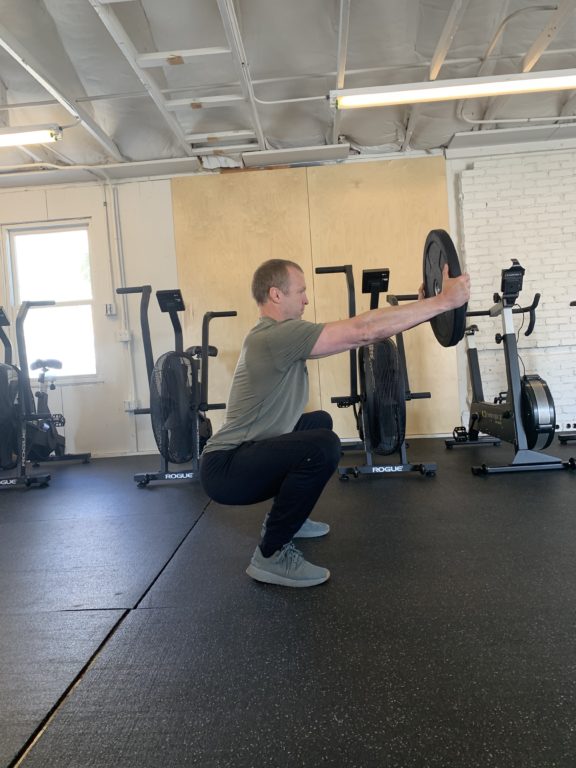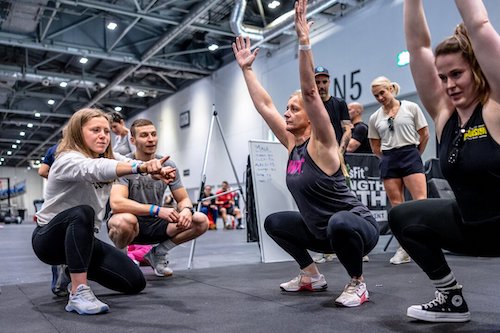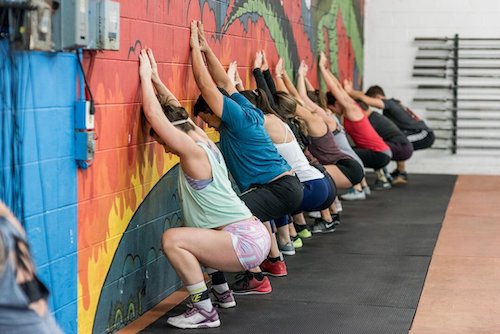To put it simply, a squat is standing from a seated position. It demands midline stabilization, posterior-chain engagement, and core-to-extremity movement, and it can be used to move your bodyweight or very large loads held in a variety of positions. At one end of the spectrum, the squat is an essential component of weightlifting and powerlifting, and at the other end, the squat is essential to the demands of everyday life. There are many variations and countless benefits to squatting.
The squat can be commonly seen in day-to-day movements such as standing from your desk chair or toilet. If you watch a toddler or small child play, you’ll notice that they move through a squat continually while moving about in space. The squat is a natural movement and, like any functional movement worth learning, it must be practiced in order for it to remain sound.
What is an Air Squat?
The air squat is the cornerstone movement of CrossFit and represents one of the most functional ranges of motion a body can go through.
CrossFit recommends all athletes begin with an air squat — that is, without any weight other than bodyweight. As proficiency in the air squat improves, athletes can move toward the weighted squat variations: back squat, front squat, and overhead squat.
An athlete will know they’re ready to move from the air squat to weighted variations once proficient in the points of performance across multiple reps.
What Are the Benefits of Squatting?
The squat is a fundamental movement pattern required for remaining functionally independent as one ages and for developing and improving athleticism. Routine squatting will keep your hips, back, and knees sound and functioning in your senior years.
Regarding athleticism, the squat is the quintessential hip-extension exercise, and hip extension is the foundation of all good human movement. Powerful, controlled hip extension is necessary and nearly sufficient for elite athleticism. Without powerful, controlled hip extension, you are not functioning anywhere near your athletic potential.

Just as important, the squat is a compound movement that can produce power and is among those exercises that elicit a potent neuroendocrine response (a response in the body with a neurological and/or hormonal effect) — this benefit alone is ample reason to include squatting in your training regimen.
The squat is no more an invention of a coach or trainer than is the hiccup or sneeze. It is a vital, natural, functional, component of your being. The squat, in the bottom position, is nature’s intended sitting posture (chairs are not part of your biological makeup), and the rise from the bottom position to the standing position is the biomechanically sound method by which we stand up. There is nothing contrived or artificial about this movement, and the benefits of it abound.
How Do I Squat With Proper Form?
Performing a proper squat requires significant mobility throughout the body, but the ability to move all the involved joints through their available ranges of motion does not necessarily ensure a perfect squat. The squat also requires considerable motor control, meaning the athlete must be able to efficiently utilize their available motion through proper muscle activation. While poor mobility is often blamed for poor movement, motor control is just as important. A thorough understanding of the mobility and motor-control needs of the squat will help athletes and coaches choose the best corrective exercises to optimize performance in this movement.
The points of performance for the squat are:
- Heels between hip and shoulder width, toes slightly turned out.
- Gaze forward.
- Hips travel back as knees bend.
- Chest stays up.
- Lumbar curve maintained.
- Heels stay down.
- Knees track in line with toes.
- Hips descend lower than knees (below parallel).
- Stand to full hip extension to complete the movement.
Common Flaws in the Squat and How To Fix Them
Most Common Faults
- Surrendering of the lumbar curve at the bottom.
- Not breaking the parallel plane with the hips.
- Knees shooting forward excessively to initiate the descent.
- Lifting the heels.
- Knees caving in.
- Not fully extending the hip at the top.
If any of these faults are present in your squat, it indicates that the most critical points of performance are lacking and should be addressed before adding load. Adding load to a squat when there is an inability to maintain the lumbar curve in the bodyweight air squat could lead to injury and most certainly blunts the benefits of adding load.
Correcting the Mechanics of Your Squat
- Focus on lifting your chest from the floor.
- Raise your arms.
- In the case of hyperextension, focus on tightening the abdominals.
To break parallel:
- Spend time in the bottom position of a squat while holding onto a pole or squat rack support beam for assistance.
- Squat to a target below parallel to assist with building awareness of proper range of motion. Ensure that the target is removed over time.
To use the correct line of action (prevent knees shooting forward):
- Focus on reaching the hips back.
- Start facing away from a wall with heels approximately 6-12 inches away and focus on reaching the hips toward the wall.
To keep your weight in your heels:
- Lift your toes up throughout the rep.
- Pull your hips back in the bottom position.
To make sure your knees track your toes:
- Focus on pressing your knees away from each other.
- Focus on spreading the floor apart with your feet.
- Put a band around your knees and focus on pressing your knees outward into the band.

Counterbalance squat
To develop a more mature squat position:
- Practice squat therapy.
- Use a counter-balance. Hold a kettlebell in a goblet-squat position or a light plate in front of the chest.
- Focus on pulling your hips into your ankles at the bottom of the rep.
To reach full hip extension at the top:
- Squeeze glutes at the top of the rep.
- Squeeze quads at the top of the rep.
- Slow down!
An immature squat, where the athlete excessively leans the torso forward (due to inflexibility and poor posterior-chain engagement) is not considered a “fault” if all of the points of performance are maintained. However, this position is far from ideal and loaded movements will be compromised.
When flaws are present in an athlete’s squat, the likely culprits are:
- Inflexibility. Tight ankles and tight hamstrings are powerful contributors to slipping into lumbar flexion. Maintaining a neutral spine in this movement is the most important point of performance. If lumbar flexion is present, it is a hard stop to progressing to weighted variations.
- Quad dominance. Attempting to squat primarily with the quads; i.e., not sending the hips back and down as you descend/knees shoot forward before the hips go back. An athletic imbalance that prevents optimal athletic development, but can be fixed by squatting properly.
- Weak glutes/hamstrings. The glutes and hamstrings are responsible for powerful hip extension and are engaged dramatically when descending below parallel.
- Poor neuromuscular control (a disconnect between the brain and the requisite muscle groups). The road to powerful, effective hip extension can take years to develop for athletes new to the squat.
- Poor focus, underestimating the challenge of this “simple” movement. The squat takes incredible effort. The more you work on the squat, the more awareness and appreciation you will develop as to its complexity and potency.
 The good news is that the best way to address any weakness in the squat is to practice squatting without load. The corrective work is in working hard to hit each of the points of performance in the squat until it becomes second nature. This will be hard work and for some beginner athletes a few sets of 10 air squats three times/week for a few weeks with a rigorous focus on mechanics is all they need to begin to increase the neurological connections needed to perform an air squat with sound mechanics. For some, it may take longer to also increase flexibility or strengthen the muscles. Either way, this is valuable work that will pay off in the long run both in terms of functional competence and athletic development.
The good news is that the best way to address any weakness in the squat is to practice squatting without load. The corrective work is in working hard to hit each of the points of performance in the squat until it becomes second nature. This will be hard work and for some beginner athletes a few sets of 10 air squats three times/week for a few weeks with a rigorous focus on mechanics is all they need to begin to increase the neurological connections needed to perform an air squat with sound mechanics. For some, it may take longer to also increase flexibility or strengthen the muscles. Either way, this is valuable work that will pay off in the long run both in terms of functional competence and athletic development.
Having your squat evaluated by a credentialed CrossFit trainer is a good first step in addressing technical issues with the movement. With the help of your trainer, you can identify the points of performance that need to be improved in your squat and you can work together on drills that will get you on the right path.
Which Muscles Are Worked in the Squat?
The squat relies on lower-body musculature. Correct execution targets the hamstrings and glutes, but the quadriceps and adductors are heavily involved as well. In addition, the abs, obliques, and erectors need to contract forcefully to maintain trunk stability throughout the movement.
Can I Squat if I’m Injured?
If an athlete is dealing with an ailment that prevents them from squatting to a full range of motion (crease of the hips below the top of the knees), squatting to a target like a box or a medicine ball is a great way to continue working the movement pattern. Find a depth at which you do not experience pain when squatting and work from there.
Can I Squat if I Have Bad Knees?
 Not only is the squat not detrimental to the knees, but it is also remarkably rehabilitative of cranky, damaged, or delicate knees. In fact, if you do not squat, your knees are not healthy regardless of how free of pain or discomfort you are. This is equally true of the hips and back. Ensure that you start with a number of reps and assess for pain and recovery capacity before progressively increasing reps and adding load.
Not only is the squat not detrimental to the knees, but it is also remarkably rehabilitative of cranky, damaged, or delicate knees. In fact, if you do not squat, your knees are not healthy regardless of how free of pain or discomfort you are. This is equally true of the hips and back. Ensure that you start with a number of reps and assess for pain and recovery capacity before progressively increasing reps and adding load.
Many individuals have been told by their doctor or chiropractor that they should not squat. In nearly every instance, this is pure ignorance on the part of the practitioner. When doctors who do not like the squat are asked, “By what method should your patient get off the toilet?” they are at a loss for words.
What Are the Different Variations of the Squat?
The squat can be seen in many different movements in addition to the air squat. Keeping company with the air squat as a bodyweight movement is the single-leg squat. Weight-bearing squats include the front squat, back squat, overhead squat, and Zercher squat. With either barbells or dumbbells, athletes will also pass through a squat in the thruster, squat clean, medicine-ball clean, wall-ball shot, and squat snatch.
What Is a Squat?